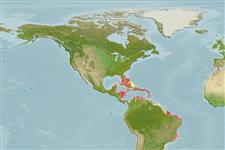Common names from other countries
>
Eupercaria/misc (Various families in series Eupercaria) >
Scaridae (Parrotfishes) > Sparisomatinae
Etymology: Sparisoma: Latin, sparus = a fish with a golden head + Greek, soma = body (Ref. 45335).
More on author: Valenciennes.
Environment: milieu / climate zone / depth range / distribution range
Écologie
marin récifal; profondeur 1 - 12 m (Ref. 9710). Tropical; 33°N - 30°S, 89°W - 31°W
Western Atlantic: Bermuda, Florida (USA), Bahamas, and eastern Gulf of Mexico through central America to Santa Catarina, Brazil (Ref. 57756).
Taille / Poids / Âge
Maturity: Lm ? range ? - ? cm
Max length : 20.0 cm TL mâle / non sexé; (Ref. 7251); common length : 15.0 cm TL mâle / non sexé; (Ref. 5217)
Épines dorsales (Total): 9; Rayons mous dorsaux (Total): 10; Épines anales 3; Rayons mous anaux: 9. Front of upper jaw has horizontal canine-like tusks. 2 scales between bases of pelvic fins (Ref. 26938). Drab-phase fish are olivaceous to yellowish brow, finely speckled with pale dots, many are conjoined; base and axil of pectoral fins broadly blue-green. Terminal-phase males are greenish brown with faint pale dots, some scales with reddish edges; irregular orange-red markings on opercle; a blackish bar at pectoral base; a broad blackish border posteriorly on caudal fin (Ref. 13442).
Mostly found in seagrass beds in shallow, protected waters. Feeds primarily on epiphytes and seagrass blades, leaving crescent bite marks. Darts into seagrass when frightened (Ref. 9710).
Life cycle and mating behavior
Maturité | Reproduction | Frai | Œufs | Fécondité | Larves
Robins, C.R. and G.C. Ray, 1986. A field guide to Atlantic coast fishes of North America. Houghton Mifflin Company, Boston, U.S.A. 354 p. (Ref. 7251)
Statut dans la liste rouge de l'IUCN (Ref. 130435)
CITES (Ref. 128078)
Not Evaluated
Menace pour l'homme
Reports of ciguatera poisoning (Ref. 30303)
Utilisations par l'homme
Pêcheries: d'intérêt potentiel; Aquarium: Commercial
Plus d'informations
RéférencesAquacultureProfil d'aquacultureSouchesGénétiqueElectrophoresesHéritabilitéPathologiesTraitementMass conversion
Outils
Articles particuliers
Télécharger en XML
Sources Internet
Estimates based on models
Preferred temperature (Ref.
115969): 26.1 - 28.2, mean 27.5 (based on 693 cells).
Phylogenetic diversity index (Ref.
82804): PD
50 = 0.5000 [Uniqueness, from 0.5 = low to 2.0 = high].
Bayesian length-weight: a=0.01072 (0.00695 - 0.01651), b=3.13 (3.00 - 3.26), in cm Total Length, based on LWR estimates for this species & Genus-body shape (Ref.
93245).
Niveau trophique (Ref.
69278): 2.0 ±0.0 se; based on diet studies.
Résilience (Ref.
120179): Haut, temps minimum de doublement de population inférieur à 15 mois (Preliminary K or Fecundity.).
Fishing Vulnerability (Ref.
59153): Low vulnerability (10 of 100).
